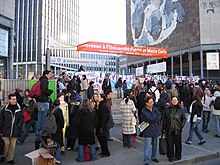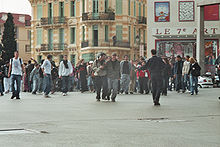Contrat première embauche
The Contrat Première Embauche , abbreviated to CPE, German contract when first hired , was part of the implementation of the flexicurity concept of the European Union in France and was intended to introduce another type of employment contract . The law was ratified by the National Assembly on February 10, 2006 and withdrawn by the government on April 7, under pressure from nationwide student protests .
On January 16, 2006 , Prime Minister Dominique de Villepin announced the law. This contract would have been applicable to employees under the age of 26 in companies with more than 20 employees. During the first two years of the employment relationship, the employee could have been dismissed without justification and without warning.
In contrast to the Contrat nouvelle embauche (CNE), which is only aimed at small and medium-sized companies, the CPE would have been open to all companies. It would have been accompanied by a three-year exemption for the employer from all incidental wage costs.
The CPE was part of the Loi pour l'égalité des chances bill (French: “Equal Opportunities Act”). According to the UMP , it should also represent a reaction to the unrest in France in 2005 , without protection against dismissal , more jobs for young people and young adults are to be created, especially in the suburbs.
The amendment, which included the Contrat Première Embauche in the draft, was passed by the French National Assembly on the night of February 8th to 9th, 2006 in a marathon meeting. The whole draft was ratified by the National Assembly on February 10th without a vote because it was not within the time frame of 24 hours after the application of “49.3” (“quarante-neuf-trois”, article 49, paragraph 3 of the constitution = resolution of a bill by the Assemblée nationale without a vote) a motion of censure was tabled by the Prime Minister on February 9th. The National Assembly can only oppose a 49/3 by submitting a motion of censure within 24 hours and overthrowing the government as a result of the motion of censure.
According to a survey by the CSA Institute for Le Parisien newspaper on March 30, 2006, the vast majority of French (83%) were in favor of withdrawing the CPE.
Since March there have been nationwide mass demonstrations, protests and, in some cases, occupations of institutions and universities by young people and students, such as the Sorbonne , which was forcibly cleared by the police.
On April 7, 2006, following the ongoing protests , the French government finally announced that it would withdraw the law “immediately” and replace it with a new regulation that would involve employers' associations and unions.
Design of the CPE
As with the Contrat nouvelle embauche , the entrepreneur is given the opportunity to dismiss his employees for a trial period without any reason. As compensation, a terminated person is entitled to a severance payment of 8% of the total wages received up to the point of termination, and after more than 4 months of service, an additional allowance of 490 euros per month for two months. The severance payment must be borne by the employer and does not need to be taxed by the employee; the state pays for the allowance. It should be noted that in this case, from a legal point of view, termination does not constitute termination, but only the end of the probationary period. This explains the nature of the unilateral termination option without any reason or warning. The notice of termination requires advance warning if the employment relationship has lasted more than a month.
Internships and fixed-term employment contracts are fully offset against the two-year probationary period if they took place in the same company. Temporary employment contracts can also be designed as a Contrat Première Embauche.
A young person who has been hired through such a contract has the right to 20 hours of further training per year from the second month of service. It is unclear how an employee should enforce this right.
All 18 to 25 year olds as CPE employees are entitled to the so-called Locapass . This makes it easier to rent an apartment, as the deposit for the apartment is made available as a loan and a guarantee for up to 18 months' rent is assumed. A CPE is legally a permanent employment contract. French Prime Minister Dominique de Villepin and Baudouin Prot , chairman of the Association of French Banks, stress that this employment contract also allows access to bank loans. However, banks and other lenders do not need a justification for declining a loan to an employee with a CPE contract.
Reactions
Cons
church
The Archbishop of Dijon, Roland Minnerath, described the project as an attack on the rights of the individual .
Unions
The unions condemn the uncertainty the CPE creates and the erosion of labor law . They criticize the treatment of workers as “throwaway objects” (salarié jetable) .
Position of the Confédération française démocratique du travail (CFDT) union :
- Developing a precarious employment contract specifically for young people is a strange perception of intergenerational equity. It is nothing more than age-related discrimination that completely goes against what young people can expect in terms of social cohesion. Young people have the same right to consideration as all other employees.
Position of the Union Syndicale Solidaires :
- This measure will not reduce unemployment, even if Villepin claims it does. The hiring brake is not in the content of our employment contracts: Companies only hire staff when they need it! The CPE will push back all other employment contracts. Because if you offer companies simple disposable workers, young workers will soon be blackmailed for two years because employers can never have enough! (Press release of January 26, 2006).
Position of the Confédération générale du travail (CGT) union :
- The CGT fears the blackmailing of employees into overtime and unpaid overtime for the purpose of profit maximization if employers can fire their employees for no reason.
The Confédération nationale du travail (CNT) union writes in a leaflet:
- This new contract allows [...] to submit the employees completely to the will of their boss. The managing directors can now hire people as it suits them without having to deal with the “harassment” such as notice periods, reasons for dismissals or severance payments. In addition: How dare you claim your rights and defend yourself when you can just get fired from one day to the next?
Student unions and youth organizations
Various youth organizations (employee unions, student unions, political and cultural groups such as the UNEF , Jeunes CGT, MJS , MJCF, UEC, Fédération SUD Étudiant, UNL, JCR, PRS jeunes, UNSA jeunes, JRG, Jeunes Verts and the Fédération Léo Lagrange ) and called for the formation of local protest groups.
Two other student organizations ( Confédération étudiante (Cé) and FAGE ) are also protesting against the CPE, but have not joined the alliance.
After the March 7 protests, the UNEF President called on all universities to join the strike.
Political parties
Position of the Parti socialiste (PS):
- This new contract is not a new opportunity for the young people, but represents nothing more than another gift to the companies, which can now get rid of their employees without giving any reason. Should the CPE be adopted, it will replace not only permanent contracts but also temporary contracts. Without any impact on unemployment.
Position of the Parti communiste français (PCF):
- The Villepin government and the MEDEF only pretend to be concerned with the problem of youth unemployment, which is particularly acute in France, by emphasizing the insecurity of everyone and everyone and by exempting employers from social security contributions. With the Contrat nouvelle embauche and the CPE, workers' rights are under even greater fire. (CN of February 24, 2006)
Position of the Union pour la démocratie française (UDF):
- The UDF opposes the CPE. François Bayrou is particularly critical of the fact that termination no longer requires any justification or justification. Education Minister Gilles de Robien has nevertheless been positive about the CPE.
Position of the Ligue communiste révolutionnaire (LCR):
- The LCR rejects the CPE on principle, relies on extra-parliamentary mobilization against these and other measures perceived as neoliberal attacks by capital and the government: now is the time to bring the right, neoliberalism and entrepreneurs to their knees; The task now is to mobilize all wage earners and young people together to stop a policy that focuses on layoffs, precarization and repression, and to put an end to this illegitimate government and its reactionary policies. (Resolution of the Congress of the LCR, January 19-22, 2006)
Position of the Lutte Ouvrière (LO):
- The LO is based on the assumption that the CPE curtails the rights of employees in favor of employers and contributes to a further deregulation of employment relationships and to the precariousness of the living situation of young workers in particular. The CPE can be stopped by mobilizing those affected by these measures, the "pressure of the street" could force the government to withdraw the CPE and CNE.
Per
Employers' associations
The employers' association MEDEF welcomed the creation of the CPE on the grounds that there was no age limit. Dominique de Villepin is quoted as saying that "a company that has invested in a young person for two years will not just part with him."
“Life, health, love ... everything is risky. Why shouldn't it be the workplace? ” Laurence Parisot, MEDEF employers' association, 9/2005
Jean-François Roubaud, President of the Confederation of Small and Medium-Sized Employers (CGPME), congratulates the government on promoting stimulation of the labor market rather than social benefits.
Youth organizations
The Jeunes Populaires , the youth organization of the ruling UMP , agrees with the position of the employers' association MEDEF. The student union UNI endorses the CPE as “a permanent contract” and “a real social advance” in terms of severance pay if the employment contract is terminated.
Political parties
The ruling Union pour un Mouvement Populaire supports this essential law with all its means. The right-wing extremist Front National had also expressed fundamentally positive comments about the project.
Nationwide protests
Protests, occupations and strikes take place nationwide at 64 of the 84 universities . The presidents of some universities (Nantes, Toulouse) have also stood behind the students and in open letters called on the Prime Minister to withdraw the CPE.
- On February 7, 2006 there were nationwide protests and demonstrations against the new law in France, in which between 220,000 and 400,000 people took part.
- On March 7th, new protests flared up across France, in which between 400,000 (police information) and 1,000,000 people (union information) took part.
- On the evening of March 8, a Sorbonne building was occupied by up to 200 partially rioting students, with up to 800 more protesting in front of it. The building was cleared by CRS units on the night of March 10th to 11th . The police officers, who are pelted with chairs and fire extinguishers from inside the building, use batons and tear gas. 31 police officers and a student are injured. 11 people are arrested. Some observers then compared the mood with that during the May riots of 1968. The balance after the eviction: destroyed tables and chairs, smashed windows, the walls with slogans such as “Nous ne travaillons jamais” ”(“ We will never work anything! The deputy rector Nicolas Boudot sums it up: “The university squatters destroyed no less than six seminar rooms, five offices, two lecture halls and all drinks machines.” In addition, 200 doors were smashed and 65 basement rooms devastated The university lamented the loss of almost a dozen irreplaceable historical books worth a million euros, which the occupiers burned in the courtyard.
- On the night of March 15, after a march on the Sorbonne , violent riots broke out again, in which at least nine demonstrators were arrested and at least nine officers were injured.
- On the night of March 17th, the student protests spread again. After an initially peaceful march from Place d'Italie to Sèvres-Babylone, there were clashes between the autonomists and the police, and a newspaper stand was burned down. Demonstrators later gathered again in front of the Sorbonne and demanded the withdrawal of the police, who kept the main building and the surrounding area cordoned off. During riots on the Place de la Sorbonne, several shops and bars were devastated and a bookstore was set on fire, whereupon the police evacuated the entire area between Sorbonne, Odéon and St. Michel. Several people were arrested who participated in the devastation or who later destroyed cars and window panes in small groups. According to the police, the arrested were not students but “autonomous rioters”; 92 police officers and 18 demonstrators were injured and 187 protesters arrested.
- On Saturday, March 18, between 500,000 and 1.5 million people took to the streets in France. What was special about this was that for the first time otherwise hostile unions demonstrated with one another. In Paris alone, between 80,000 and 350,000 people took part in a demonstration from Denfert-Rochereau to the Place de la Nation. On that day, too, there were serious clashes with the police. At first, the Paris event was peaceful, until at the end of the event on the sidelines of the demonstration a car was set on fire and the windows of two shops were broken. Although the situation had initially calmed down, the police decided to break up the demonstration by force, injuring peaceful demonstrators, in particular Cyril Ferez, who, as it was later revealed, fell into a coma. The angry crowd was driven from the square in back streets, where protesters erected burning barricades, set other cars on fire and destroyed numerous shops. Later, the focus shifted back to the Latin Quarter , where the police forcibly broke up a sit-in of around 500 students demanding the clearance of the Sorbonne. There were also riots here in which the barriers around the Sorbonne were partially torn down. 166 demonstrators were arrested, 17 demonstrators and 7 police officers injured.
The unions asked the government to withdraw the law within 48 hours and threatened a general strike .
- On the weekend of 18./19. March a meeting with representatives of the universities on strike took place in Dijon , at which the further actions were coordinated nationwide.
- On Tuesday, March 21, at around 4 p.m. after a peaceful march in Paris that led from Place d'Italie to Port Royal, some demonstrators gathered in front of the cordon off Boulevard Saint Michel at the level of rue Soufflot. There were some minor riots in which the police officers were pelted with paint bags and burning mattresses, among other things. At around 6:30 p.m., the congregation slowly broke up.
- A national day of protest had been planned for March 28, on which more than 3 million people across the country took to the streets, and riots broke out again in Paris that evening. The train station in Rennes was occupied, in Caen thousands of demonstrators blocked the prefecture of the Calvados administrative district with barricades, and the police used tear gas.
- On April 5, 2006, between 3 and 5 p.m., a large demonstration with several thousand participants took place in Mulhouse, which was completely peaceful.
See also
- Contrat nouvelle embauche
- Probationary period
- Protection against dismissal
- Precariousness , precariat
- Student protest
- Unrest in France in 2005
swell
- ↑ Webjournal.ch: Thousands in Mulhouse on the streets
Web links
German
- Article in the Handelsblatt : France's youth demonstrate for protection against dismissal
- Article of the world : Protests against de Villepin's reforms
- Article of the taz : Protests against a two-year probationary period
- FAZ article : Police storm Sorbonne University in Paris
- Article about the protest at Indymedia : 1 million people demonstrate against CPE
- Telepolis on March 17th: escalation of violence in Paris
- Background article at Telepolis of March 13, 2006: Protests against the lifting of the protection against dismissal contained therein "The history of the Contrat première embauche"
- Topic page on Labornet ( Memento from June 16, 2008 in the Internet Archive )
- Telepolis on March 29th on strategies and chances of success of the opponents: After the mass protest
- Photo essay on photografree.net: CPE - tear gas and Jimi Hendrix
- Émilie Schwan: La rupture conventionnelle: The termination of the employment relationship requiring approval under French law Cologne, Univ.-Diss. 2016
French
- Weblog with detailed reports: Stop CPE ( Memento from February 24, 2006 in the Internet Archive )
- Article in the French language Wikipedia Contrat Nouvelle Embauche
- Article in the French-language Wikipedia on the Loi pour l'égalité des chances legislative package, which contains the CPE
- Article in the French language Wikipedia on the "anti-CPE movement" Mouvement anti-CPE
- Publication in the Journal Officiel de la République Française , corresponds roughly to the German Federal Law Gazette : LOI no ° 2006-396 du 31 mars 2006 pour l'égalité des chances (1)
- Survey by the CSA Institute of March 30, 2006 on the attitude of the French towards the CPE
- Article 49, paragraph 3, of the Constitution





